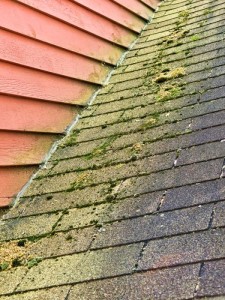Stains on asphalt roofing shingles are not only a cosmetic issue. They can be a symptom of a bigger problem that could lead to serious damage or roof failure. However, there are some steps a homeowner can take to remove stains and see if there is a underlying problem at play.
Staining Causes
There are three major conditions that can cause roof tile staining:
- Eroded Mineral Surface – If the roof-covering material has been on the house for 15 years or so, it could be that the surface granules are wearing off the shingles and the asphalt base is starting to show through. On older roofs, you may additionally see cracked and/or shingles with curled edges. If you determine that age and wear are the causes of darkening, it may be time for a new roof.
- Algae Growth – More often than not, blue, green or black stains on an asphalt-shingle roof are caused by algae. Algae staining begins with small spots which, over time,
 can develop into streaks. Algae stains, which are often mistaken for mold or mildew, aren’t harmful to anything other than the appearance of asphalt shingles, but nobody likes the look.
can develop into streaks. Algae stains, which are often mistaken for mold or mildew, aren’t harmful to anything other than the appearance of asphalt shingles, but nobody likes the look. - Moss – Green, velvety masses of moss often grow on north-facing roof surfaces and on tree-shaded roofs. Unlike algae, moss left on roof surfaces can develop beyond an aesthetic problem. It can infiltrate the roof structure underneath the shingles and make their edges lift and curl, which can lead to cracking and blow-off during high winds and storms. Heavy moss growth can actually form dams that can cause water to back up under the shingles and damage the roof deck. It’s best to clean moss off a roof as soon as you notice it’s growing there.
Safety First
Both algae and moss can be easily removed from asphalt shingles with a 50/50 solution of chlorine bleach and water. Laundry-strength bleach is sufficient, or you can opt for any of a number of proprietary roof cleaners, some of which don’t contain bleach, lye, or other potentially harmful chemicals.
It is important to follow these safety precautions when cleaning your roof:
- Wait for a calm, windless day to clean your roof.
- Spray landscape plants near the house with water and cover them with tarps to protect them from chemical overspray and runoff.
- Wear protective clothing, including long sleeves, pants and gloves, as well as goggles to protect your eyes, and shoes with high-traction soles.
- Consider using a safety harness and follow common-sense rules considering positions and using a ladder.
- Don’t do it alone. Have somewhere there to spot you.
Cleaning Moss and Algae
Apply the bleach solution with a garden sprayer. Let it stand on the surface for about 20 minutes, then rinse it off with spray from a garden hose. Don’t let the bleach solution stand on the roof for more than 30 minutes or so without rinsing. And don’t use a pressure washer, which can damage the shingles by removing their protective layer of asphalt granules.
If accumulations of algae or moss are heavy, at least some of it should wash off the roof surface right away with the stream from the hose. You can try brushing off algae and moss with a brush or broom with medium-stiff bristles, but don’t scrub too hard. You don’t want to separate the mineral granules from the shingles.
If chunks of algae or moss or heavy stains remain on the surface after rinsing, let the roof dry, then spray on the bleach solution again. Wait 30 minutes and rinse. Don’t worry if some staining remains after the second rinse. It should wash off over time with exposure to rain and sunlight.
Keeping Moss and Algae Off
Algae and moss tend to grow roof surfaces that are shaded and retain moisture. So, it’s a good idea to cut away tree branches that overhang the roof and block sunlight. Keep the roof surface clean by blowing off leaves and fallen branches during seasonal maintenance.
For long-term stain prevention, have zinc or copper strips installed under the cap shingles, leaving an inch or two of the surface exposed at roof peaks, along hips, and under the first course of shingles at the base of dormers. Copper and zinc are sacrificial metals that shed tiny bits of their surface with each rainfall. The metals coat the roof and inhibit organic growth for many years.

